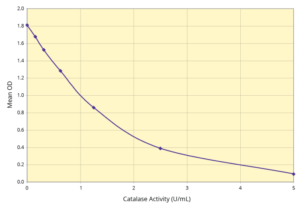As climate change and the human population continues to increase, understanding the impact these changes have on our world and the species it harbors becomes ever more critical. Experimental understanding of the stress responses of key animal species can provide a means of quantitatively measuring the biological impact of factors like temperature change, xenobiotic contamination, crowding, and resource loss individually or in combinations that mimic projected real world conditions.
Oxidative stress in organisms is well recognized as an important early indicator of both xenobiotic toxicity and environmental stress. Biomarkers for oxidative stress, such as the activity of enzymes responsible for the regulation of reactive oxygen species (ROS), can therefore be used to provide standardized quantitative measures of oxidative stress to assess the health and stability of the ecosystem as a whole.
Hydrogen peroxide (H₂O₂) (K034-H1, F1) is one of the most abundant ROS, formed either environmentally or internally through the normal biochemical processes of the cell. The careful regulation and the rapid removal of excess H₂O₂ is essential for all prokaryotic and eukaryotic cells living in aerobic environments. The enzyme catalase catalyzes the decomposition of H₂O₂ to the much less reactive products oxygen and water. It is a highly conserved enzyme found in nearly all living organisms (animals, plants and bacteria) that are exposed to oxygen. Catalase is also an incredibly effective enzyme, having one of the highest turnover numbers known. A single molecule of catalase can break down millions of molecules of H₂O₂ per minute. While nearly all biological samples will show catalase activity, an increase in catalase activity vs. control can be used as an indicator of oxidative stress.
Catalase Activity Kits
Arbor Assays has designed the catalase activity kit in both a colorimetric detection system (K033-H1), as well as a fluorescent detection system (K033-F1). Both DetectX® Catalase Activity Kits are designed to quantitatively measure catalase activity in a wide variety of samples, including serum, plasma, cells, tissues, and erythrocyte lysates.
In a recently published book, authors used our Catalase Activity Kit (K033-H1) to assess the oxidative stress response from freshwater crabs exposed to silver nanoparticles and temperature stress. Silver nanoparticles are frequently used in the manufacture of a variety of goods for their antibiotic properties, but the toxicity of these particles in the environment was not well understood. The study was able to determine threshold toxicity levels for the key test species under various environmentally relevant conditions, which may lead to a broader understanding of the potential impact of silver nanoparticles on the environment and suggest ways to limit the exposure and spread of this contaminant. The study of oxidative stress response in key environmental species offers an important window into understanding the impact of human activity on the environment and, ultimately, the planet as a whole.
